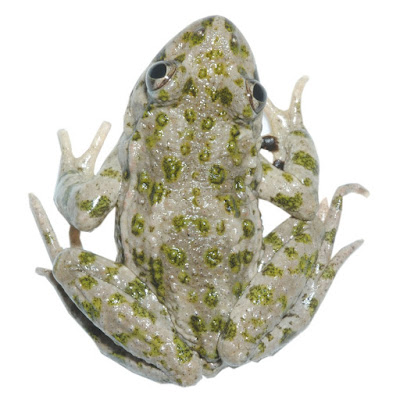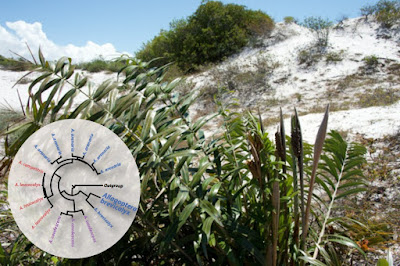[Most Recent Entries] [Calendar View]
Tuesday, March 14th, 2017
| Time | Event | ||||
| 8:53a | [Herpetology • 2017] Pelodytes atlanticus & P. hespericus • Integration of Molecular, Bioacoustical and Morphological Data Reveals Two New Cryptic Species of Pelodytes (Anura, Pelodytidae) from the Iberian Peninsula
Abstract Parsley frogs (Pelodytes) comprise the only genus in the family Pelodytidae, an ancient anuran lineage that split from their closest relatives over 140 million years ago. Pelodytes is a Palearctic group restricted to Western Eurasia including three extant species: the eastern species P. caucasicus, endemic to the Caucasus area, and two closely related species inhabiting Western Europe: the Iberian endemic P. ibericus and the more widespread P. punctatus. Previous studies based on mitochondrial and nuclear DNA markers have revealed the existence of two additional lineages of Parsley frogs in the Iberian Peninsula, which have been flagged as candidate species. Here, we integrate novel molecular, morphological and bioacoustical data to assess the differentiation of the four western Parsley frog lineages. Species trees and Bayesian population assignment analyses based on nuclear markers confirm previous studies and concordantly delineate four parapatric lineages with narrow hybrid zones. Mitochondrial divergence is low (< 2% pairwise distances in the 16S rRNA gene), in line with previously reported low mitochondrial substitution rates in non-neobatrachian frogs. Based on concordance between mitochondrial and nuclear markers, we conclude that four species of Parsley frogs occur in Western Europe: Pelodytes punctatus, distributed from northern Italy to northeastern Spain; Pelodytes ibericus, inhabiting southern Spain and southern Portugal; Pelodytes atlanticus sp. nov., from the Portuguese Atlantic coast; and Pelodytes hespericus sp. nov., occurring in central and eastern Spain. However, bioacoustical and morphological differentiation of these species is low, with no obvious and qualitative diagnostic characters allowing full species discrimination. Differences in the relative size of metacarpal tubercles exist but this character is variable. Pelodytes ibericus and Pelodytes atlanticus are smaller than the other two species, and P. ibericus has shorter limbs and various distinctive osteological characters. Bioacoustically, the pattern by which two different note types are combined in advertisement calls separates P. hespericus from the remaining species. Despite these differences, we emphasize that the taxonomic status of all four western Parsley frogs requires additional investigation, especially the patterns of genetic admixture across contact zones. While a status of separate species best conforms to the currently available data, alternative hypotheses are also discussed. Keywords: Amphibia, Pelodytidae, cryptic species, species delimitation, population assignment, Pelodytes punctatus, Pelodytes ibericus, Pelodytes atlanticus sp. nov., Pelodytes hespericus sp. nov. Taxonomy Pelodytes punctatus (Daudin, 1802) Common Parsley frog Pelodytes ibericus Sánchez-Herráiz, Barbadillo, Machordom, and Sanchiz, 2000 Iberian Parsley Frog Pelodytes atlanticus sp. nov. Etymology. The specific epithet atlanticus is a genitive adjective derived from the name of Titan Atlas who, according to the ancient greek mythology, lived beyond the strait of Gibraltar and refers to the species’ exclusive distribution along the Atlantic coast of Portugal. Pelodytes hespericus sp. nov. Etymology. The specific name is a latinized adjective derived from the name Hesperides (Ἑσπερίδες), Nymphs of the fading sun and daughters of the Titan Atlas, in allusion to an Iberian mythological garden. The Hesperian Massif also takes its name from the same etymology, meaning “western” in ancient greek, referring to its position in the Mediterranean sea.
Díaz-Rodríguez, Jesús, Marcelo Gehara, Roberto Márquez, Miguel Vences, Helena Gonçalves, Fernando Sequeira, Iñigo Martínez-Solano & Miguel Tejedo. 2017. Integration of Molecular, Bioacoustical and Morphological Data Reveals Two New Cryptic Species of Pelodytes (Anura, Pelodytidae) from the Iberian Peninsula. Zootaxa. 4243(1); 1–41. DOI: 10.11646/zootaxa.4243.1.1 | ||||
| 9:42a | [Botany • 2017] Endemic Palm Species (Allagoptera spp.) shed light on Habitat Shifts and the Assembly of the Cerrado and Restinga Floras Highlights • Inter-specific relationships within Allagoptera are revealed. • Recent origin of Cerrado and Restinga species. • Specialization to dry habitats over time. • Morphological adaptation to dry habitats found. Abstract Species expansions into new habitats are often associated with physiological adaptations, for instance when rain forest lineages colonize dry habitats. Although such shifts have been documented for the Brazilian savanna (Cerrado), little is known about the biogeographic origin of species occupying an extreme South American habitat type, the coastal dunes (Restinga). We examined the formation of this poorly known, endangered habitat by reconstructing the evolutionary history of two endemic species. Due to the proposed recency and uniqueness of this habitat, we hypothesized that Restinga species of the palm genus Allagoptera to be recently evolved and to present derived morphological characters. To detect habit shifts in absolute time, we used one plastid and nine nuclear genes to reconstruct the phylogenetic and biogeographic history of Allagoptera. We used light microscopy and stable isotope analysis to explore whether morphological adaptations occurred concomitantly with habitat shifts. Phylogenetic relationships were well supported and we found ancestral lineages of Allagoptera to be widely distributed throughout habitats that are currently occupied by extant species. Over the last ca. 7 Ma Allagoptera has shifted its preference to increasingly dry habitats. Coincident with the colonization of the Cerrado and Restinga, morphological adaptations also evolved, including subterranean stems that are fire-resistant and long underground stem and root systems that facilitate water access. We did not find differences in metabolic pathway or modifications to pollen morphology when compared to other palm lineages. Assuming that the evolutionary history of Allagoptera is indicative of the habitat in which it occurs, our results infer a recent origin for Cerrado species. Although little is known about the formation of the Restinga habitat, our results also suggest a longer history than currently proposed; with an origin of Restinga habitats dating back to the Late Pliocene. Keywords: Allagoptera; Arecaceae; Attaleinae; Cerrado; diversification; Palmae; Restinga; South America Christine D. Bacon, Monica Moraes R., Carlos Jaramillo and Alexandre Antonelli. 2017. Endemic Palm Species shed light on Habitat Shifts and the Assembly of the Cerrado and Restinga Floras. Molecular Phylogenetics and Evolution. DOI: 10.1016/j.ympev.2017.03.013 | ||||
| 3:08p | [Herpetology • 2017] Multilocus Phylogeny of Alligator Lizards (Elgaria, Anguidae): Testing mtDNA Introgression As the Source of Discordant Molecular Phylogenetic Hypotheses Highlights • Multilocus data recover a novel phylogeny for Elgaria alligator lizards. • We propose two approaches for testing hypotheses of introgression. • Ancient mitochondrial capture involving Elgaria paucicarinata is detected. • Elgaria panamintina is not closely related to Elgaria kingii. Abstract The increased availability of nuclear DNA sequence data has led to a better appreciation of the role and frequency of introgressive hybridization and subsequent mitochondrial capture in misleading phylogenetic hypotheses based on mtDNA sequence data alone. Relationships among members of the alligator lizard genus Elgaria have been addressed with morphology, allozyme and mtDNA sequence data with discordant results. In this study, we use seven nuclear loci (total of 5.9 kb) and ∼3 kb of mtDNA to infer the phylogenetic relationships among Elgaria species and test whether the discordance among previous phylogenetic hypotheses is due to introgression and mtDNA capture. While gene tree topologies varied among the different loci, we recovered a well-resolved coalescent-based species tree. Contrary to our expectations, the nDNA-only species tree does not support the sister relationship between E. kingii and E. panamintina inferred from the previous allozyme study. Nevertheless, we found evidence for possible mitochondrial capture in two unexpected situations. The first instance of mtDNA capture involves E. paucicarinata from the Cape Region of Baja California. MtDNA recovered a clade comprising E. paucicarinata and the other two peninsular endemics, while the nDNA-only species tree recovered E. paucicarinata as sister to the continental E. kingii. We hypothesize that this discordance is the result of ancient mitochondrial capture rather than incomplete lineage sorting. Additionally, analyses of nDNA recovered E. panamintina as sister to an E. multicarinata North lineage, whereas the mtDNA gene tree recovers E. panamintina nested within a southern E. multicarinata clade. We hypothesize that this discordance also may be due to mitochondrial capture. Additionally, hybridization between these two lineages may have resulted in geographically limited nuclear introgression. Divergence dating analyses suggest that oviparous Elgaria species diverged within a relatively narrow timeframe from the late Miocene to early Pliocene. We find that accounting for introgressed alleles is important when inferring phylogenetic relationships when using coalescent-based approaches. Keywords: North America; alligator lizards; Baja California; species tree; discordance; introgression Dean H. Leavitt, Angela B. Marion, Bradford D. Hollingsworth and Tod W. Reeder. 2017. Multilocus Phylogeny of Alligator Lizards (Elgaria, Anguidae): Testing mtDNA Introgression As the Source of Discordant Molecular Phylogenetic Hypotheses. Molecular Phylogenetics and Evolution. DOI: 10.1016/j.ympev.2017.02.010 |
| << Previous Day |
2017/03/14 [Calendar] |
Next Day >> |



